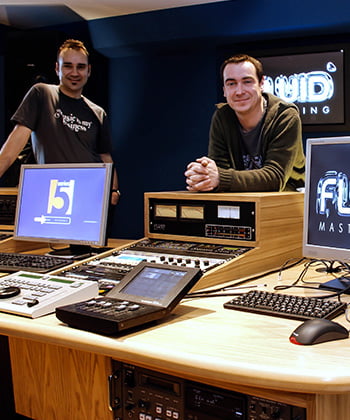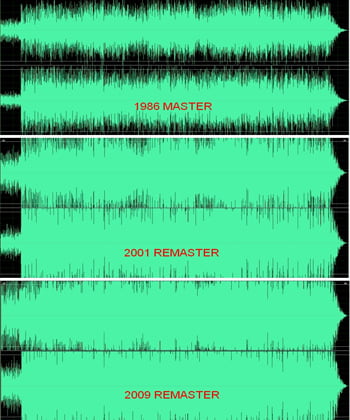Mastering
O k, many of you dear readers can probably skip this bit. But if the term mastering is new to you or you’re wondering why you’re supposed to pay good money just to have something turned up then read on…
Mastering has always been considered by many in the music industry as something of a dark art. Unlike mixing, which is fairly well understood, the process of transforming raw mixes into professional, broadcast standard, radio friendly tracks, has an air of mystery to it. Part of the reason for this is that the tools at the mastering engineer’s disposal are in essence the same as those used in the recording and mixing process; i.e. EQ (equalisation) and compression – and yet what the experienced mastering engineer can bring to a project with those tools often goes beyond the expectations of his client. This is why the mastering engineer’s contribution is often described in such ambiguous terms as “that special magic”, “bringing the tracks to life” or “making it sound like a record”.
The difference between a mastered and an unmastered track can be dramatic, or it can be subtle. It’s impossible to generalise about what mastering does because every recording has it’s own unique features; some positive which mastering would seek to enhance, and some negative which mastering would seek to remedy. In terms of EQ, there are broad issues of the general tonal content i.e. whether a track needs more or less bass or treble. But there can be more specific areas where certain frequencies dominate or are lacking, possibly due to acoustic anomalies (room modes) in the recording studio, or the response of certain processors or mics used; and the accurate correction of these can really open a track up and bring everything into perspective. Your mastering engineer may also use compression over the track, and there are many types and approaches to dynamic processing so that it can be used to add punch and fatness, or to hold a wayward lead vocal in place on the top of the mix, or simply to add that bit of “glue” that holds a mix together.
With affordable computer-based recording being so prevalent these days, a great deal of music is recorded and/or mixed in acoustically inaccurate monitoring environments. As a result of this the role of the mastering studio is more important now than ever; as it often provides the only opportunity to accurately hear what’s going on in a recording and iron out any problems. Many producers now even get their demos mastered, in order to be sure that they will compete in the marketplace.


It’s Your Mastering Session
Many artists and producers have told us of previous experiences where they have invested time and money into a mastering session only to find that the results did not live up to their expectations. We at Fluid Mastering recognise that there are any number of ways to master a recording and it’s important for us to establish what you are looking for in your final master.
If your project is commercial in nature, you probably want your master to compare with others in your genre, and to have a contemporary, dense and upfront kind of sound. In other words, you want it to be LOUD. We can do this for you. With pleasure. On the other hand, your priorities might be more towards retaining every dynamic nuance, creating a finished master which is as open and natural sounding as possible. This too we can provide! Of course, we would generally aim to find a balance between these approaches, but our priority at all times is to make sure that you get the sound you want.
The Good, The Bad, and the Downright Nasty
There are many alternatives these days to the handful of true high-end mastering studios which used to encompass the market. Whilst genuine mastering equipment is still very costly, there is now a range of more affordable options mainly in the form of computer plug-ins which has resulted in the explosion of mastering services operating today, mainly offering online mastering at sometimes very low prices, and all of them claiming to be “professional” and – that phrase again – “high-end”.
It’s undeniably a good thing that projects which in the past would simply not have had enough budget for mastering can now have the benefit of a cut-price or do-it-yourself option. However, it’s a good idea to have an understanding of the difference between genuinely high-end mastering and the cut-price alternatives, so that you know what to expect for your money.
Experience and Taste: An experienced mastering engineer will be working on several projects every week; encountering new challenges as he strives to meet the exacting demands of his clients. He is a craftsman; honing his skills and learning new ones all the time. He understands that his job is to make your music sound better; not just louder. He also knows how to bring the best out of his equipment, and how to minimise or avoid sound engineering pitfalls such as synchronisation error, jitter, quantisation distortion, clipping distortion, noise and so on.
Quality Equipment: Whatever adjustments your engineer chooses to apply to the spectral and dynamic content of your recording, there is the potential for damage to be done if he’s not using the highest quality equipment available. We’ve tested some of the popular plug-ins available at the moment and found that – surprise surprise – something costing a few hundred quid really doesn’t sound as good as something costing several thousand. Budget plug-ins can make your music sound flatter and greyer as well as removing front-to-back depth; effectively making a perfectly good recording sound like a cheap and nasty one.
Accurate Monitoring: Accurate Monitoring is the product of the speakers, amps, and the room they’re in. It’s the most important aspect of a mastering setup, and it’s one thing you can’t emulate in software. Mastering monitors are designed to be neutral, not flattering, and are different to control-room monitors used for tracking and mixing. Without the accuracy of good mastering monitors, an engineer wouldn’t be able to judge the EQ and dynamics of a recording precisely, and wouldn’t be able to hear the damage done by excessive or inappropriate processing.

Mastering for MP3 and Download
Most mastering procedures today involve a digital end-product, and the majority of these are in the form of a linear PCM recording with a 44.1KHz sample rate. This is the format used on Audio CDs (appropriately dithered to 16 bit word depth), and therefore is also the most common source from which MP3s and other data-compressed downloadable files are derived, the main exception being Apple’s “Mastered For iTunes” AAC files.
Consequently your preferred distribution format, whether it is CD or download, will make no difference to the end-format of your mastered audio. It will be PCM digital audio at 44.1KHz, which we can give to you in the form of WAV or AIFF files, or as an Audio CD or DDPi Master. In the vast majority of cases, there will be a CD Master, and for download the digital aggregator will encode MP3s (or AACs in the case of standard iTunes) from a clone of that master. We can of course encode and tag your MP3s for you if you wish.
There is one consideration to bear in mind when you’re expecting to distribute your music in the form of MP3s, and that is loudness. We will refer to the so-called “Loudness War” later on this page, but on the subject of MP3s it is important to remember that super-loud masters make for bad MP3s. The reason for this is that when presented with a fully or over-modulated pcm signal, intersample peaks can occur in the MP3 encoder, which has insufficient headroom to handle them causing additional distortion. So, if you want your MP3s to sound as good as possible, let us leave a little headroom in mastering.
The Loudness War
Pretty much the hottest topic in the field of audio production in recent years has been the so-called “Loudness War”, which is the vicious cycle that has been driving up the volume and driving down the quality of the music we all listen to, since the mid 1990s. As we have mentioned elsewhere on this website, your engineer at Fluid will be only too happy to provide you with a super-hot master if that’s what you want, and our expertise enables us to achieve higher levels without the degree of damage normally associated with brickwall limiting. However, it’s a good idea to understand what you lose by over-cooking your master so that you can make an informed choice.
It’s now being more widely recognised that super-hot masters, with the clipping distortion and marginalised dynamic range that they exhibit, can have a fatiguing effect on the listener (as well as the more audible artifacts), which means that even if you like the sound initially, it will probably turn you off over time (until you turn it off!). The more obvious side effects however become clear when you compare the before and after signals with the listening levels appropriately compensated. If you attend your session we will be able to demonstrate this to you so that you can make up your own mind.
If you’d like further information on this topic we recommend the following external sites:





